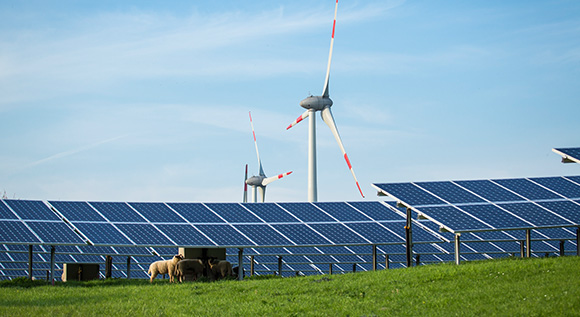Funding renewable energy in an efficient way
Pilot auctions for ground-mounted PV installations prove to be a real success: the Federal Ministry for Economic Affairs and Energy is paving the way for competition-based funding for green technologies.
 © Federal Ministry for Economic Affairs and Energy/Holger Vonderlind
© Federal Ministry for Economic Affairs and Energy/Holger Vonderlind
More than 30 per cent of Germany’s electricity now come from renewable sources. In the first half year of 2015, the share of renewables in electricity consumption reached a record high of 32.5 per cent. In ten years time, it is to reach 40 to 45 per cent. Funding renewables is no longer about helping new technologies enter the market, but reaching expansion targets in time and in a way we can afford. Newly installed systems have to be able to hold their ground in the face of competition. The revision of the Renewable Energy Sources Act (German abbreviation: EEG) of 2014 serves as the basis for this. In order to move away from fixed, government-controlled funding rates and towards greater competition, an auction scheme has been set up.
Pilot auctions for solar farms are a first step in this direction. Operators of new ground-mounted solar installations are only entitled to funding under the Renewable Energy Sources Act if they have taken part in a bidding process and their bid is successful. The bidders demanding the lowest funding amount will be given the contract. So the key question is: Who will bid for less?
In other words, funding will go to those who ask for less money. In future, this rule shall also apply to other green technologies. According to current plans, the funding process for renewables is to be changed to an auction scheme by 2017. The main points are laid out in a paper drafted by the Federal Ministry for Economic Affairs and Energy, which is undergoing public consultation. The paper focuses on onshore and offshore wind energy, as well as photovoltaics. These technologies are to contribute most to the expansion targets defined as part of the revised version of the Renewable Energy Sources Act of 2014. More than 80 per cent of the electricity generated by newly installed renewables installations could receive funding as part of the auction scheme. An auction for big offshore wind farms must of course be designed differently than an auction for PV systems on buildings. Consequently, we will hold separate auctions, focusing on each technology individually.
Plannability, competition, diversity: Main objectives
The auctions will focus on three objectives: plannability, competition, and diversity. In order to control the increase in new installations, the volume up for auction is fixed. Auctions also promote competition between the operators. The funding awarded to operators will be just enough to cover the cost-efficient operation of the installations. That is the underlying principle of the auction scheme. This is also to the benefit of customers, as it is they who bear the costs for funding renewables under the Renewable Energy Sources Act. At the same time, we want to maintain diversity in the sector. There are many different players, including large companies, co-operatives, farmers, and individual investors. SMEs in particular often prove to be especially innovative.
Funding reduced for ground-mounted PV installations
The second round of auctions for PV systems, which ended in September 2015, has also shown that there is real competition for receiving funding. This bodes well for the energy transition. A total of 136 bids – covering a volume of 558 megawatts (MW) – were submitted, with the auction volume of 150 MW oversubscribed more than three times over. Some 33 of the bidders were awarded a contract. The winning bids will receive funding of 8.49 Euro cents for every kilowatt-hour (€ct/kWh) of electricity that is fed into the grid. This is significantly less than the amount of 8.93 €ct/kWh that was granted until 1 September 2015. According to the Federal Network Agency, which is responsible for organising the bidding process, the second round of auctions has shown that "operators that are perhaps seen as less professional are also able to make a competitive offer and win a contract".
Information on which bids were selected, on where new solar farms are to be built, and on the second round of auctions is available online from the Federal Network Agency. Bids for the third round of auctions have to be submitted by 1 December 2015.
Pay-as-bid versus uniform pricing auctions: How is the level of funding determined?
During the first round of auctions for ground-mounted PV installations, prices were still determined using the so-called 'pay-as-bid' procedure. Every successful bidder received a contract based on the price specified in their bid. This means that every solar farm received a different amount of funding. Now, in the second and third round of auctions, the 'uniform pricing procedure' is being tested. Here too, bids are ranked according to their price, with the bidders demanding the lowest funding amount then being selected – until the volume up for auction (150 MW during the last auction) has been reached. However, each solar farm receives the same funding amount, which is based on the last successful bid. The same price mechanism is also used on the electricity exchange.
The Federal Network Agency assesses and evaluates the results of the pilot auctions. Based on this, the Federal Ministry for Economic Affairs and Energy will submit an evaluation report to the Bundestag before the end of 2015. The findings of this report can help improve the auction design for funding other forms of renewable energy.

